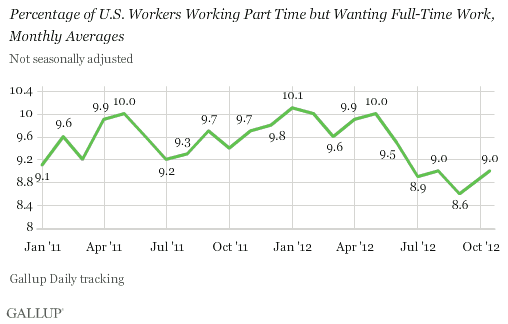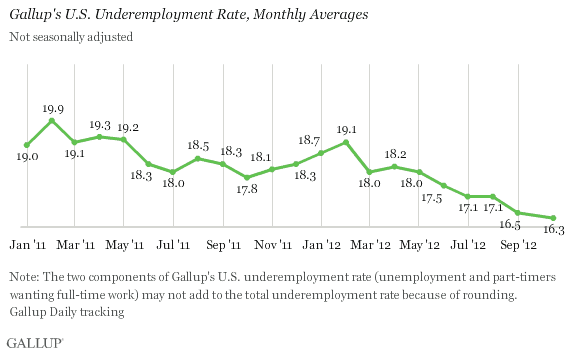WASHINGTON, D.C. -- U.S. unemployment, as measured by Gallup without seasonal adjustment, is 7.3% in mid-October, down considerably from 7.9% at the end of September and at a new low since Gallup began collecting employment data in January 2010. Gallup's seasonally adjusted unemployment rate is 7.7%, also down from September. October's adjusted mid-month measure is also more than a percentage point lower than October 2011.

These results are based on Gallup Daily tracking surveys conducted by landline and cell phone with more than 30,000 U.S. adults from Sept. 16-Oct. 15. Gallup's seasonally adjusted unemployment rate incorporates the .04 upward adjustment used by the U.S. Bureau of Labor Statistics (BLS) in October of last year. The adjustment for September was an increase of .02, which explains the .04 drop in seasonally adjusted employment despite the .06 decline in the unadjusted number.
The percentage of Americans working part time but wanting full-time work is 9.0% in mid-October, up from 8.6% in September, but still better than 9.4% in October 2011.

Despite the increase in the percentage of Americans working part time but wanting full-time work, the underemployment rate declined slightly to 16.3% in mid-October. Gallup's U.S. underemployment measure combines the unemployed with those working part time but wanting full-time work. The underemployment rate is at its lowest mid-month or monthly level Gallup has measured since it began collecting employment data in 2010.

Implications
The decline in unemployment but uptick in the number of Americans working part time but looking for full-time work is likely the result of seasonal hiring, which picks up in the fall for Halloween and continues through the end of the holiday season. Still, seasonally adjusted employment, which accounts for these types of periodic fluctuations, has declined modestly since the end of September. This is a promising sign that employers are adding jobs that will last into the new year.
Gallup's mid-month unemployment numbers are a good early predictor of the monthly numbers released by the BLS. The decline in Gallup's unadjusted and adjusted employment rate suggests that the BLS may report another decline when it releases the October data on Nov. 2.
Gallup.com reports results from these indexes in daily, weekly, and monthly averages and in Gallup.com stories. Complete trend data are always available to view and export in the following charts:
Daily: Employment, Economic Confidence, Job Creation, Consumer Spending
Weekly: Employment, Economic Confidence, Job Creation, Consumer Spending
Read more about Gallup's economic measures.
View our economic release schedule.
Survey Methods
Results are based on telephone interviews conducted as part of the Gallup Daily tracking survey Sept. 16-Oct. 15, 2012, with a random sample of 30,000 adults, aged 18 and older, living in all 50 U.S. states and the District of Columbia, selected using random-digit-dial sampling.
For results based on the total sample of national adults, one can say with 95% confidence that the maximum margin of sampling error is ±1 percentage point.
Interviews are conducted with respondents on landline telephones and cellular phones, with interviews conducted in Spanish for respondents who are primarily Spanish-speaking. Each sample includes a minimum quota of 400 cell phone respondents and 600 landline respondents per 1,000 national adults, with additional minimum quotas among landline respondents by region. Landline telephone numbers are chosen at random among listed telephone numbers. Cell phone numbers are selected using random-digit-dial methods. Landline respondents are chosen at random within each household on the basis of which member had the most recent birthday.
Samples are weighted by gender, age, race, Hispanic ethnicity, education, region, adults in the household, and phone status (cell phone only/landline only/both, cell phone mostly, and having an unlisted landline number). Demographic weighting targets are based on the March 2011 Current Population Survey figures for the aged 18 and older non-institutionalized population living in U.S. telephone households. All reported margins of sampling error include the computed design effects for weighting and sample design.
In addition to sampling error, question wording and practical difficulties in conducting surveys can introduce error or bias into the findings of public opinion polls.
For more details on Gallup's polling methodology, visit www.gallup.com.
